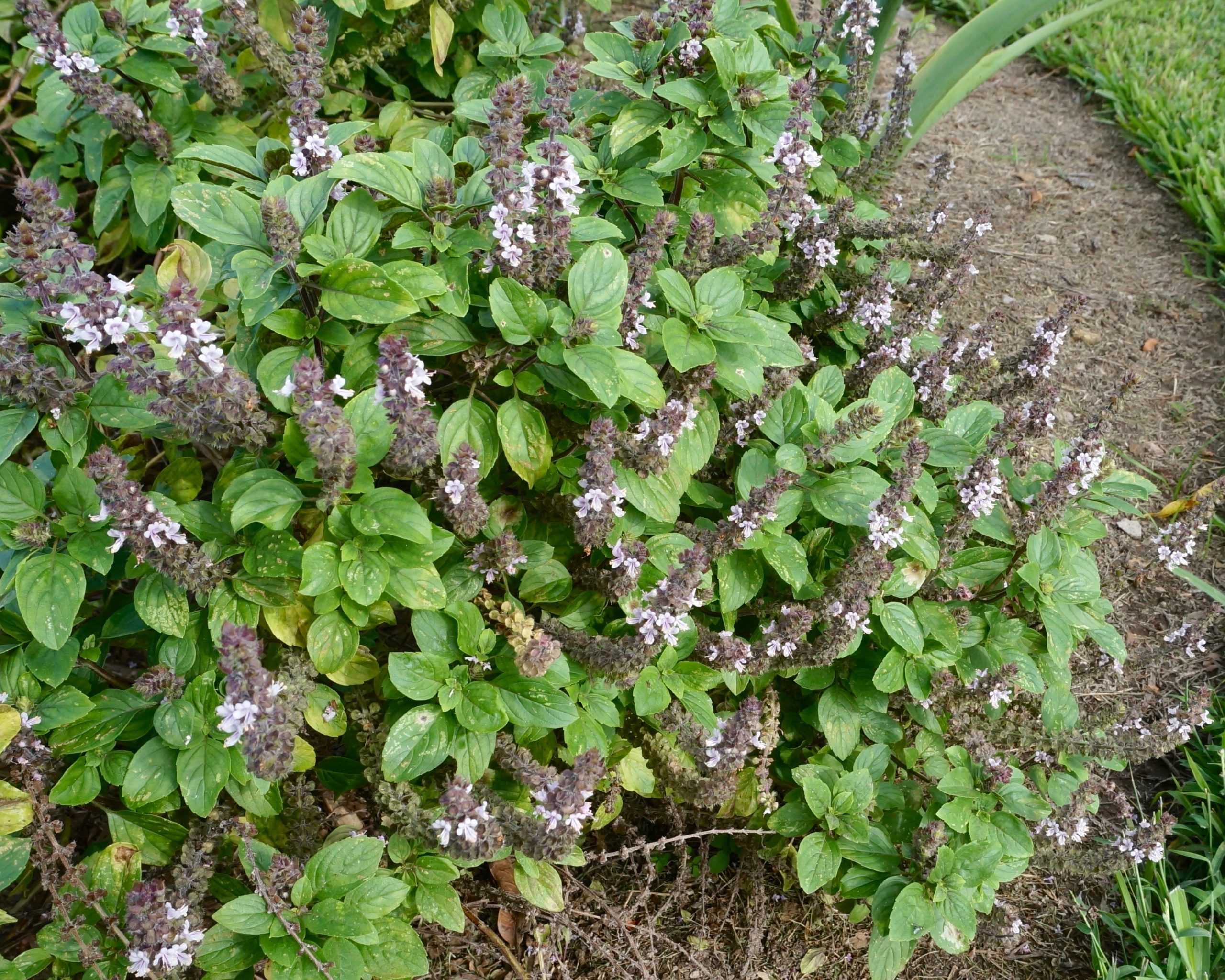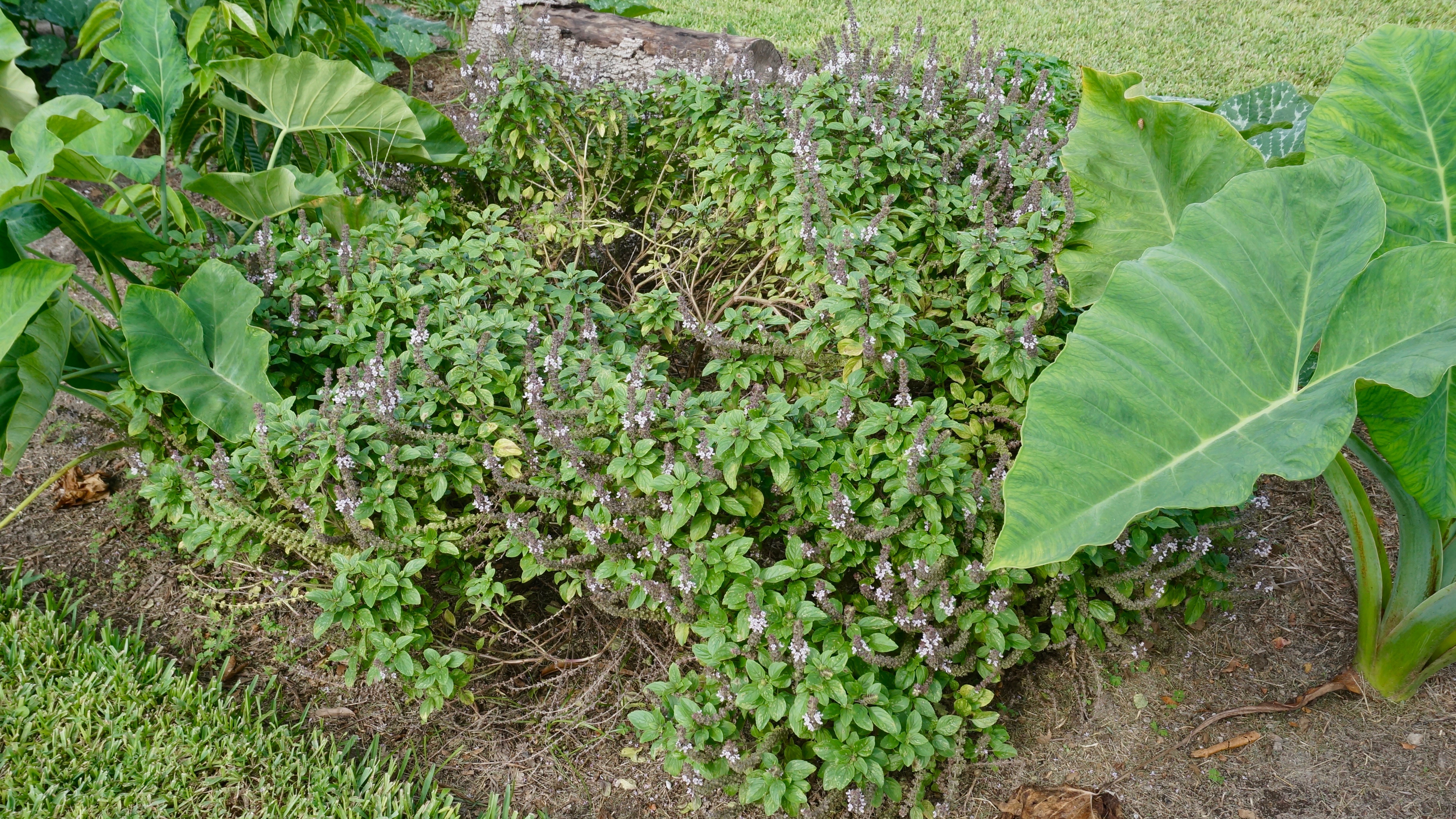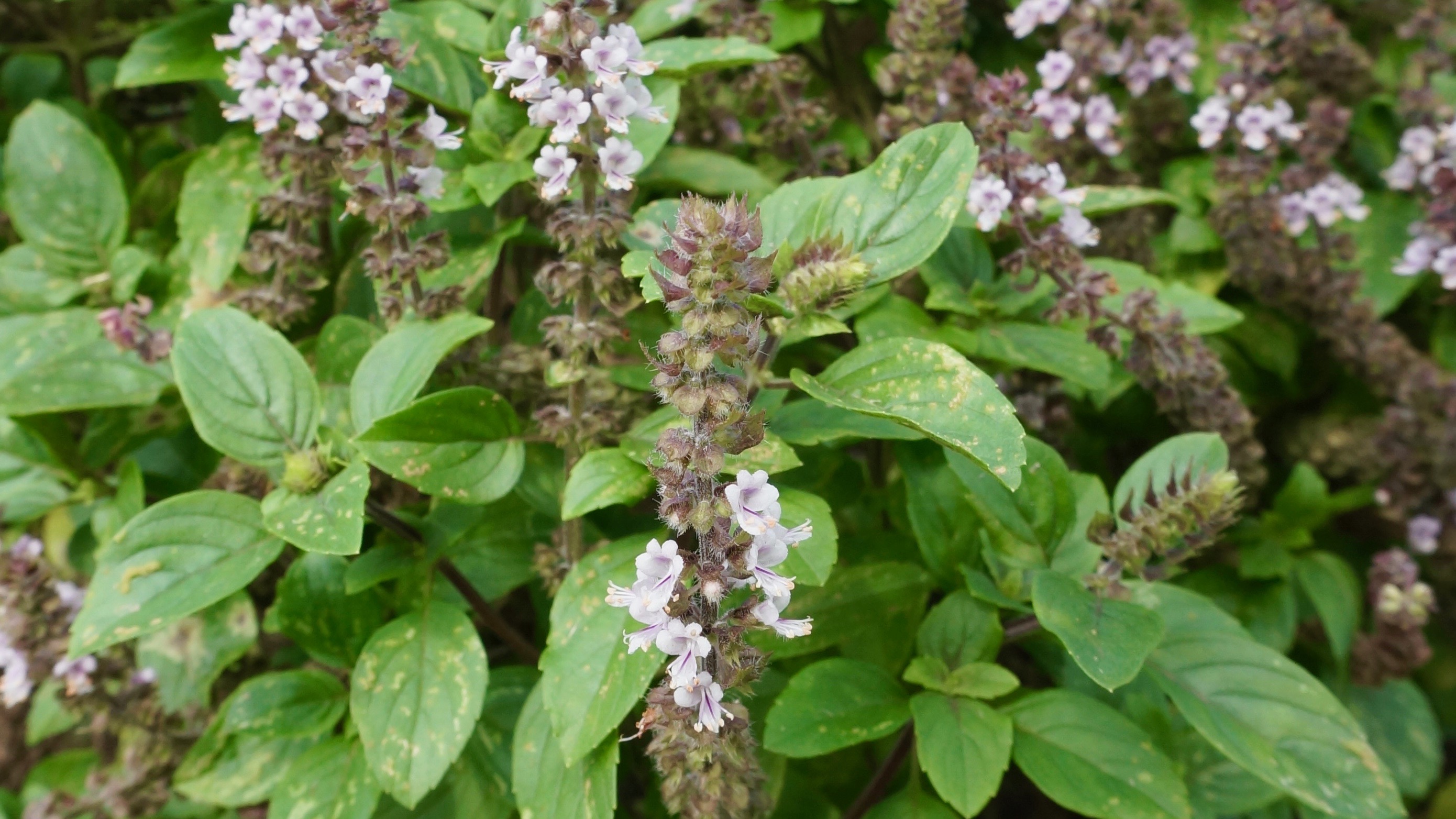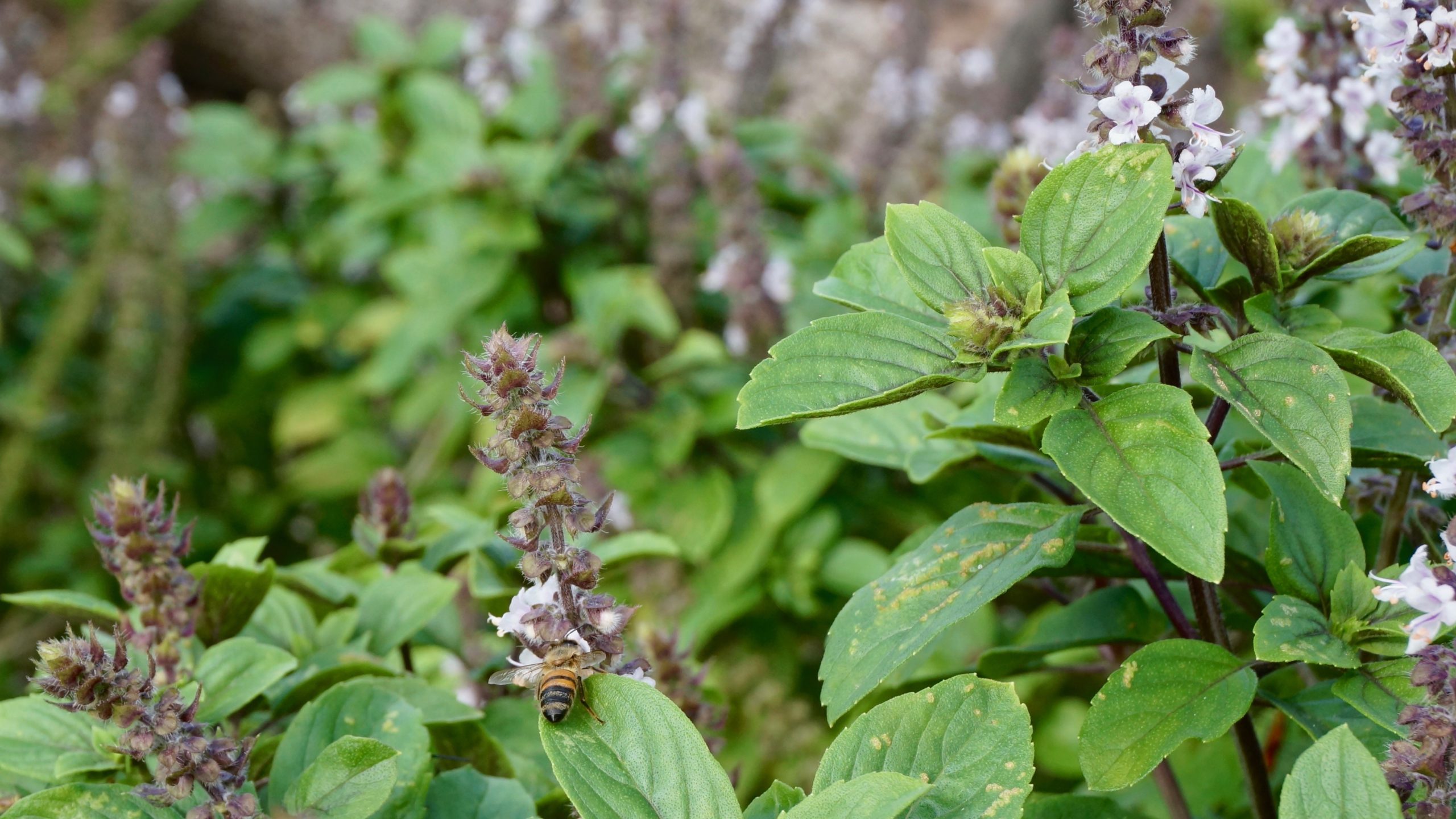All Posts > Herbs > Perennials > Plant Profiles

Introducing African Blue Basil
African blue basil is a perennial hybrid basil that was created by crossing two basil species. The first species is Ocimum kilimandscharicum, which is also known as ‘camphor basil.’ While the second species is Ocimum basilicum; this is the same species as the common sweet basil, but it is a different cultivar known as ‘dark opal.’ The latin name for African blue basil is Ocimum kilimandscharicum x basilicum 'Dark Opal’.
I bought this plant when I went on a trip to Fort Meyers to visit ECHO. ECHO is an organization that focuses on reducing world hunger by sharing knowledge on growing food in tropical climates. They have a farm in Fort Meyers where they teach people the knowledge they have acquired. You can learn more about them here.
History
The first record we have of African blue basil is in 1983 when Peter Borchard, the owner of Companion Plants in Athens, Ohio found it in his garden. It was growing on its own near some of his camphor and dark opal basil plants. The camphor basil is native to East Africa and has a high camphor content. The African blue basil inherited its strong camphor scent and flavor from this plant, but it does have a lower camphor content than camphor basil. The dark opal basil has a flavor similar to sweet basil and purple leaves, which is where African blue basil inherited its purple colored leaves.

Growth Habit of Bush
This basil hybrid is a perennial species in mild climates like that of South Florida. The stems first start out green and flexible but eventually become woody and brittle. As seen in the image above, the branches grow up and then begin falling over from their weight. This causes a hole in the center of the foliage, however, the bush quickly fills in again with new growth. This leads to this basil bush growing wide and round. It can reach widths of around 5 feet and heights of 3 feet. The young leaves start off purple on the underside and, as they get older, eventually turn green with purple veins and flecks.
The bush can also withstand heavy pruning. I have cut a plant back almost to the ground and it has grown back from the woody stems. Since it can be heavily pruned I believe this plant can possibly be overwintered, if protected, in climates that are a bit cooler. This basil grows more vigorously in full sun, while in the shade the bush does not grow as fully. I have only grown it in the ground, but it is likely to do very well growing in a pot. I also have not seen the African blue basil effected by any pests in South Florida.

Growth Habit of Flower
The African blue basil flowers all year long in South Florida. The flowers start growing at the tips of the stems. The immature flowers are dark purple and the mature open ones are lavender. The flowers are all borne on stalks that can reach at least 6 inches long. The flowers on the lower part of the stalk open first and as the stalk continues to crow new flowers are borne that will eventually open.
Propagation
African blue basil is sterile because it is a hybrid. This means it doesn’t produce any seeds even though it flowers profusely. The only method of propagation I am familiar with is by soft wood cuttings. It may be possible to propagate it by root or hard wood cuttings, but I am not sure if that can be done.
Uses in the Kitchen
African blue basil has many uses. It can be used as a sweet basil replacement. The camphor flavor is strong, so some people do not like it. However, if you use it as an ingredient in dishes then the camphor flavor is lessened. The best dish I have made with this basil is a pesto pasta where I replaced the sweet basil with equal parts of African blue basil and spinach. Since the amount I used was less than the recipe required the camphor flavor was not overpowering.

Uses in the Garden
The African blue basil is frequently grown as an ornamental because of its purple leaves and constant flower production. Another benefit in the garden is that it attracts a large amount of beneficial insects. My plants are always buzzing with many different species of bees and wasps. It is a great plant to intercrop into any garden or food forest to increase pollination of your other plants.
I absolutely love African blue basil. Have you ever seen it growing or grown it yourself? If yes, what recipes have you used it in? Have you tried propagating it? Leave a comment and let me know down below. You can learn more about the plants I am growing here and read any of my recent posts here. If you don’t want to miss another post then subscribe so you can receive updates on any new ones.
Learn about other heat and sun tolerant herbs by watching this video. Skip to 4:08 to see me talk about African blue basil.
The search photo of the African Blue Basil is accurate, but the photos in the article look like they are showing the camphor Basil.
The ABB has purple stems and leaf veining. The camphor does not, and I feel the leaves are almost fuzzyish to touch. This is a problem for some nurseries are passing the camphor and other basils as the ABB. Some even say they are still sowing seeds when asked if they have any-it’s a sterile plant.
I do not grow any camphor basil and all the photos were taken by me of my African Blue Basil plants. I obtained my original African Blue Basil plant by a reputable nursery a number of years ago and have continued to propagate it only by cuttings. The plant doesn't produce any viable seeds.
Hi! I work for the University of Florida and would like to know if I could use your photo of Ocimum hybrid ‘African Blue’ kilimandscharicum x O. basilicum ‘Dark Opal’ in a bee app I'm creating. You would receive attribution of course. Could you direct email me?
Hi! I work for the University of Florida and would like to know if I could use your photo of Ocimum hybrid ‘African Blue’ kilimandscharicum x O. basilicum ‘Dark Opal’ in a bee app I'm creating. You would recieve attribution of course. Could you direct email me?
Zone 11b coastal cal I grow af. blue basil in a 25 gal pot with yarrow and alyssum, all does well together & I've seen some native bees in with the parade of honeybees. Growing blue basil in pots is easy and effective, only problem is they outgrow containers quickly!
That is good to hear! The bees love them. Yes they will outgrow a pot quick. They are very vigorous growers and in a year I will have a huge plant.
Do you have cuttings for sale
Email me if you are interested in purchasing African blue basil cuttings. ourtropicalsoil@gmail.com
I am feeding senior apt community. We have no bees in our gardens. Where can I purchase these plants. I need 4??? Manual propergation is not working. Plants looking bad. Desperation Webster Texas!
Hello, I am not familiar with where you can purchase a plant locally in your area but if you are interested in rooted cuttings you can email me at ourtropicalsoil@gmail.com .
African blue basil is easy to root from soft stem cuttings; place in glass container with filtered water in a sunny location like window sill and within days you will see roots forming. I have these cuttings in starter mix for setting out. Wow, from one plant I have many new ones for my butterfly garden. Central Florida bees love this plant.
Thank you for the advice. Yes that is the method I use. I put the cuttings in water but only some of them develop roots. Then when I transplant to soil most of them end up dying. Maybe it is because I am not using filtered water.
African Basil Dark Opal is like cocaine to my bees. I had to pull it out because bees wouldn't pollinate any of my vegetable plants with this basil around! I tried it different seasons with melon and cucumbers - bees wouldn't even pollinate my zucchini!!! Not a single fruit! Anyone know of a good flower to attract bees yet also have them pollinate vegetables?
Wow! That is interesting. I have not heard about that happening before. Do you have better luck with pollination now that you have removed the African blue basil? I also have a powderpuff tree that attracts bees but no where near as much as the African blue basil. Maybe that species would be helpful for you.